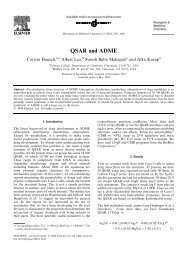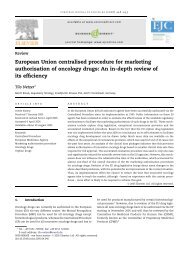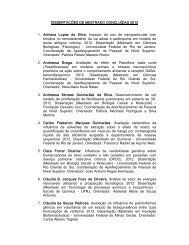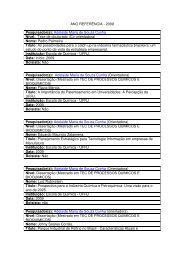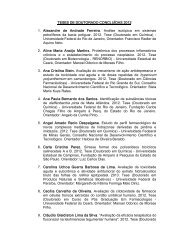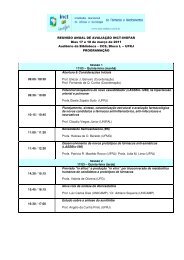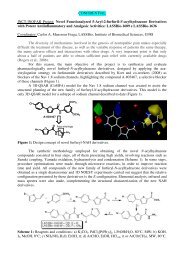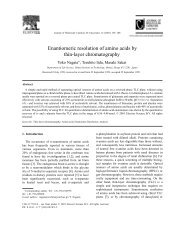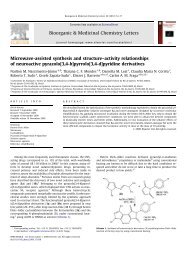Annual Activities Report 2011 - INCT-Inofar - UFRJ
Annual Activities Report 2011 - INCT-Inofar - UFRJ
Annual Activities Report 2011 - INCT-Inofar - UFRJ
You also want an ePaper? Increase the reach of your titles
YUMPU automatically turns print PDFs into web optimized ePapers that Google loves.
<strong>Annual</strong> <strong>Report</strong> <strong>2011</strong> | <strong>INCT</strong>-INOFAR<br />
50<br />
Highlights<br />
Gold(I) complexes with thiosemicarbazones:<br />
cytotoxicity against human tumor<br />
cell lines and inhibition of thioredoxin<br />
reductase activity<br />
Josane A. Lessa a , Juliana C. Guerra b , Luana F. de Miranda b , Carla F. D. Romeiro b , Jeferson G. Da Silva a ,<br />
Isolda M. C. Mendes c , Nivaldo L. Speziali d , Elaine M. Souza-Fagundes b and Heloisa Beraldo a * J. Inorg.<br />
Biochem. 105 (<strong>2011</strong>) 1729-1739. DOI:10.1016/j.jinorgbio.<strong>2011</strong>.09.008<br />
Platinum-based drugs belong to the blockbusters of anticancer drugs sold worldwide. However, many<br />
tumors are intrinsically resistant to these compounds and even the initially sensitive tumors can develop<br />
a resistance during treatment. In addition, the compounds cause severe side effects. Hence there is an<br />
increasing demand for novel metal-based-pharmaceuticals with a mode of action differing from that of the<br />
platinum anticancer drugs. Recently gold complexes have attracted major attention due to their tumor cell<br />
growth inhibiting effects, and their interactions with enzymes such as thioredoxine reductase (TRxR). The<br />
antitumor properties of thiosemicarbazones and their metal complexes have been extensively investigated.<br />
However to our knowledge studies on gold complexes with thiosemicarbazones have not involved<br />
investigation on their interaction with TrxR.<br />
Complexes [Au(H2Ac4DH)Cl]∙MeOH (1) [Au(H 2<br />
2Ac4Me)Cl]Cl (2) [Au(H 2<br />
2Ac4Ph)Cl]Cl∙2H 2<br />
O<br />
(3) and [Au(H 2<br />
2Bz4Ph)Cl]Cl (4) were obtained with 2-acetylpyridine thiosemicarbazone (H2Ac4DH),<br />
its N(4)-methyl (H2Ac4Me) and N(4)-phenyl (H2Ac4Ph) derivatives, as well as with N(4)-phenyl<br />
2-benzoylpyridine thiosemicarbazone (H2Bz4Ph). The compounds were investigated for their cytotoxic<br />
activities against Jurkat (immortalized line of T lymphocyte), HL-60 (acute myeloid leukemia), MCF-<br />
7 (human breast adenocarcinoma) and HCT-116 (colorectal carcinoma) tumor cell lines. Since TrxR is<br />
considered as the most relevant molecular target for gold compounds, inhibition of TrxR’s activity by the<br />
studied gold(I) complexes was investigated.<br />
Molecular plot of [Au(H 2<br />
2Ac4DH)<br />
Cl]Cl•H 2<br />
O (1a, left) and<br />
[Au(H 2<br />
2Bz4Ph)Cl]Cl (4, right)<br />
Jurkat and HL-60 leukemia cells were more sensitive to the compounds than MCF-7 and HCT-116 cells.<br />
The studied compounds were more cytotoxic than auranofin against Jurkat and HL-60 cells but were in<br />
general less active than auranofin against MCF-7 and HCT-116 cells. Many of the studied compounds




